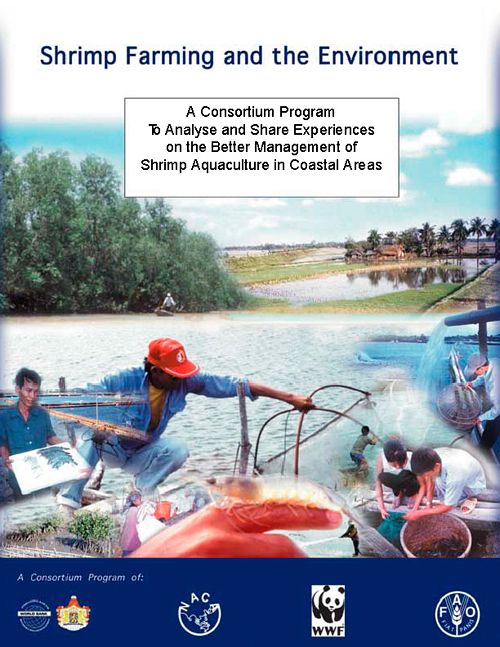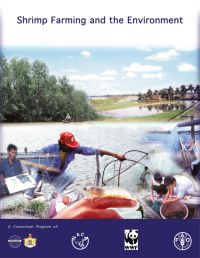Shrimp Farming and the Environment: A Consortium Program to Analyse and Share Experiences on the Better Management of Shrimp Aquaculture in Coastal Areas
1 July 2005 | 952 Downloads | .pdf | 1.3 MB | Better management practices, Genetics and Biodiversity, Health and Biosecurity, Livelihoods, gender and social issues, Nutrition and feeding, Aquatic plants, Shrimp, Environment and Sustainability, Water quality
This report provides details of the activities and outcomes of work conducted under the World Bank, NACA, WWF and FAO consortium program on Shrimp Farming and the Environment.
Aquaculture is an important economic activity in the coastal area of many countries and offers a number of opportunities to contribute to poverty alleviation, employment, community development, reduction of overexploitation of natural coastal resources, and food security in tropical and sub-tropical regions. Global production of farmed aquatic animals and plants in 1999 reached 42.8 million MT with a value of US$ 53.6 billion. Of this, crustacean farming (shrimp, prawn and other minor crustaceans) accounted for about 3.7% of the total yield and represented 16.5% of the total revenue from aquaculture worldwide. The yield from shrimp farming alone represented about 2.6% of the total aquaculture output that year. In 2000, 1.1 million MT at a value of about US$ 6.9 billion of shrimp was produced, with yields from shrimp aquaculture representing more than 28% of the total shrimp market. The three main cultivated shrimp species (P. monodon, P. vannamei, and P. chinensis) account for more than 82% of total production. While P. monodon ranked 20th by weight in terms of global aquaculture production by species weight in 1999, it ranked first by value at US$ 4.05 billion (FAO 2002). The annual average increase in farmed shrimp production was 5-10% in the 1990s. This achievement was driven by the high value and market demand for shrimp that attracted considerable private and public sector investment.
Development of coastal aquaculture, and shrimp farming in particular, has generated debate in recent years over the social and environmental costs and benefits. Rapid expansion of shrimp farming in some countries in Latin America and Asia has focused attention on the need for effective management strategies. Such strategies are needed to enhance the positive contributions that shrimp farming and other forms of coastal aquaculture can make to economic growth and poverty alleviation in coastal areas, while controlling negative environmental and social impacts that may accompany poorly planned and regulated developments.
Recognizing that challenges for better management of shrimp aquaculture around the world are complex, and that improved practices often result from identifying and analyzing lessons learned and exchanging such information, the Consortium Program entitled "Shrimp Farming and the Environment" has been developed. The partners are the World Bank, the Network of Aquaculture Centres in Asia-Pacific (NACA), the World Wildlife Fund (WWF) and the Food and Agriculture Organization of the United Nations (FAO). The consortium supported some 35 complementary case studies prepared by more than 100 researchers in more than 20 shrimp farming countries. These cases have been developed through consultation with numerous stakeholders throughout Asia, Africa and the Americas. Cases range from specific interventions within single operations to thematic reviews of key issues in shrimp aquaculture. The overall goal is to document and analyze experience around the world in order to better understand what works, what doesn’t and why.
This report synthesises the major findings of the consortium program from 1999 till March 2002. It includes the outcome from a stakeholder workshop that discussed the program findings, hosted by the World Bank in Washington DC, in March 2002. Individual case study reports are being released in hard copy and via a web site www.enaca.org/shrimp. This synthesis report and the case study reports are intended for use and discussion among stakeholders to ensure that the findings from the Program have broad impact and relevance.
Copyright, all rights reserved.

